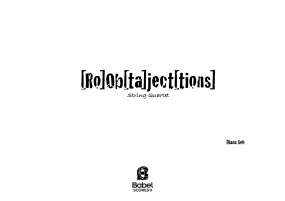Ghozne
ISMN : 979-0-2325-6480-7
- Identifiez-vous pour créer une liste
Although Futurism and Cubism explore movement as séed and acceleration, Duchamp goes to the contrary towards delay and deceleration, towards its decomposition to make its internal structure clear to us. For example, the Nude Descending a Staircase from 1912 is this decomposition and the descent into the underworld of apparitions, it goes from the painting of movement to what is beyond movement, we appreciate the microstructure in the slowing down, in involution. Instead of the vertigo of movement is the vertigo of delay, (micro)analysis, defer, stop, dilate, delay, go back clockwise... Cubism turned into mental surgery, desintegration of space in the reverse of speed, thus the static representation, or ecstatic?, of a changing object is discovered. Representing not the verve of Futurism, but the rigor of Duchamp's ironic-scientific thought. In this way the subject becomes a dimension of the object, its reflexive dimension, its gaze, on the one hand a precipitate of pure time, and on the other, time itself, its brutal urgency, the imminence of now.
Another aspect in Duchamp thinking, space becomes a philosophical and hilarious machine, he refutes delay with irony... with the metaphysics of meta-irony... in a continuous reflection on the work, irony that destroys its own negation, and thus becomes affirmative, by physically and mentally unfolding and retracting, it shows us other views, other appearances of the same object, elucidative, here is there, interior is exterior, back is forward, up is down, left is right, we look looking ourselves, it is a hinge - operation.
There is a point at which these contradictions cease: the hinge... and it ceases to be immediately reborn, transformed: the hinge is at the same time the resolution of the contradiction and its metamorphosis into another contradiction. The dialectic between apparition and appearance is reproduced, multiplied in the fold, in the hinge, in Mallarmé's hand fan, in the hinge... the identity bifurcates, the mirror unfolds, the hinge becomes a material axis and spiritual of the universe.
As for the instruments, all strings, they establish the space-time distance, first fixing certain points, and then unfolding microtonal spectrum, opening distances of different speeds in multidimensional field filling in various ways the interstitial spaces between the points of a vibrational way, as enunciated by String Theory.
Thus, an intricate “spider web” is established in which each intersection is a bifurcation, a hinge. In this network, the position of the bow on the strings provides color to space-time both in a plastic and musical way, providing an appropriate timbre to each of these space-times depending on its location, duration, weight, color, transparency, light, dark, etc.
The massive presence of the 88 vibrating strings covering the entire audible microtonal spectrum, makes us enter into sets of frequencies in large areas of said spectrum, considering that the total entropy would be the white noise or the sum in equal parts of the energy of all the frequencies of space-time. This gives the music perspective and depth of field, creating various dimensional multi-universes, the product of this unfinished but inexhaustible Duchampian delay.
O.Paz, M.Duchamp, S.Torre
Pages - 64






